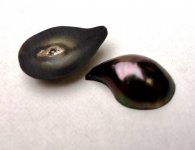jshepherd
Pearl Paradise
We have a project underway that involves slicing pearls (those at the ruckus will see the unveiling of the reason why ) and I thought this Tahitian keshi was particularly interesting. You can still see the small pocket of organic matter in the center. I think I've only seen this in an X-ray before.
) and I thought this Tahitian keshi was particularly interesting. You can still see the small pocket of organic matter in the center. I think I've only seen this in an X-ray before.
Enjoy!
Enjoy!

